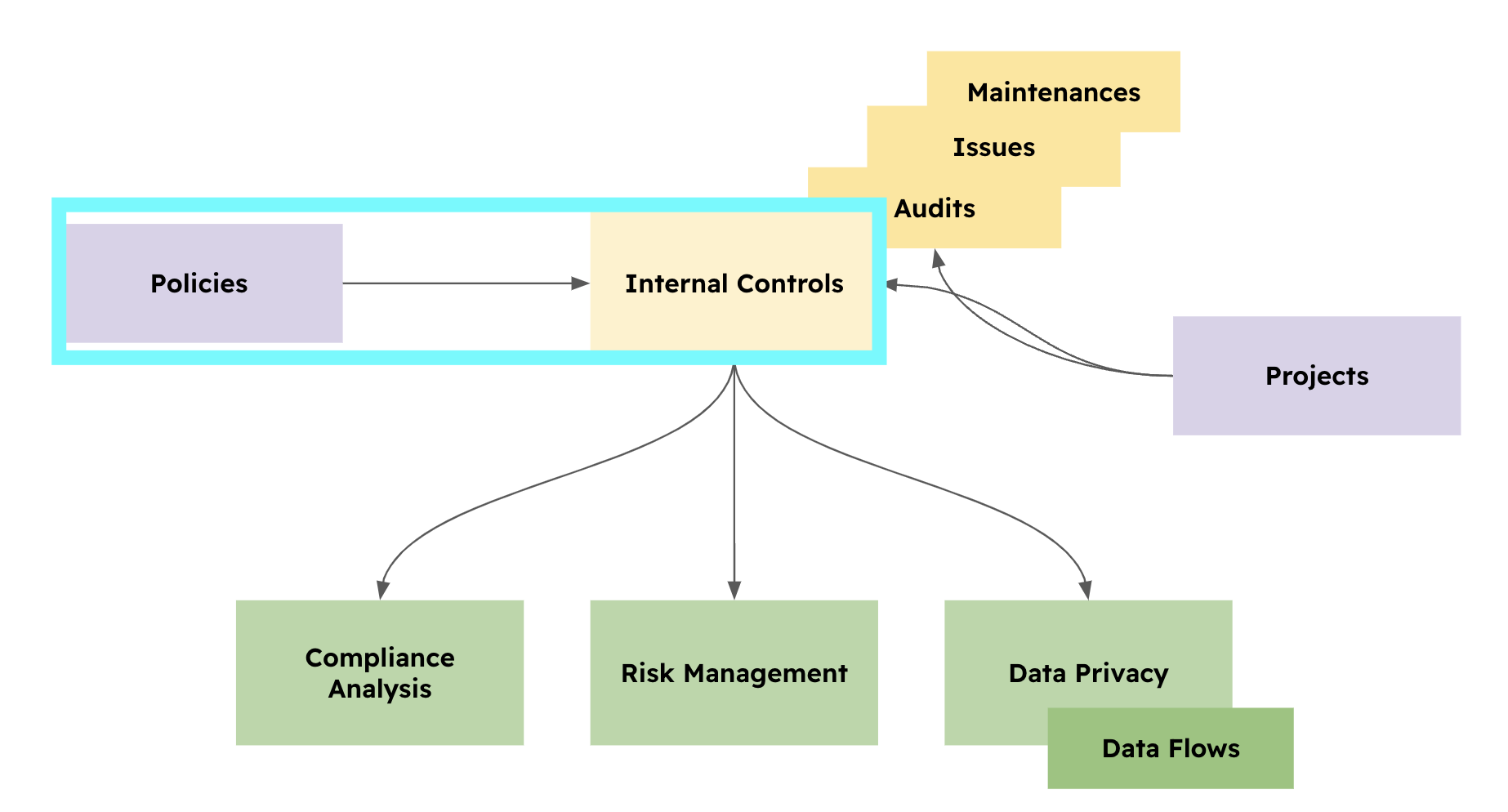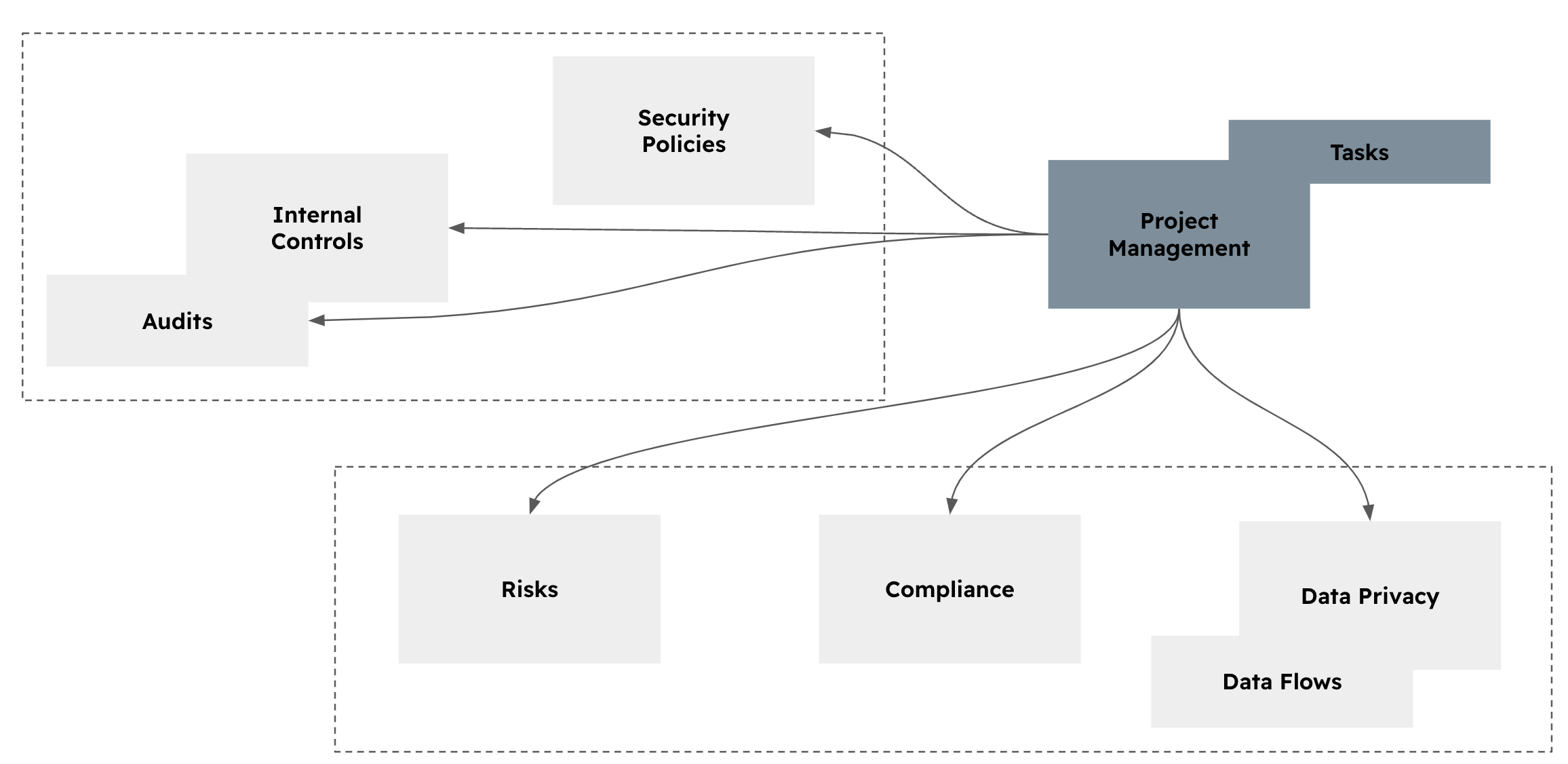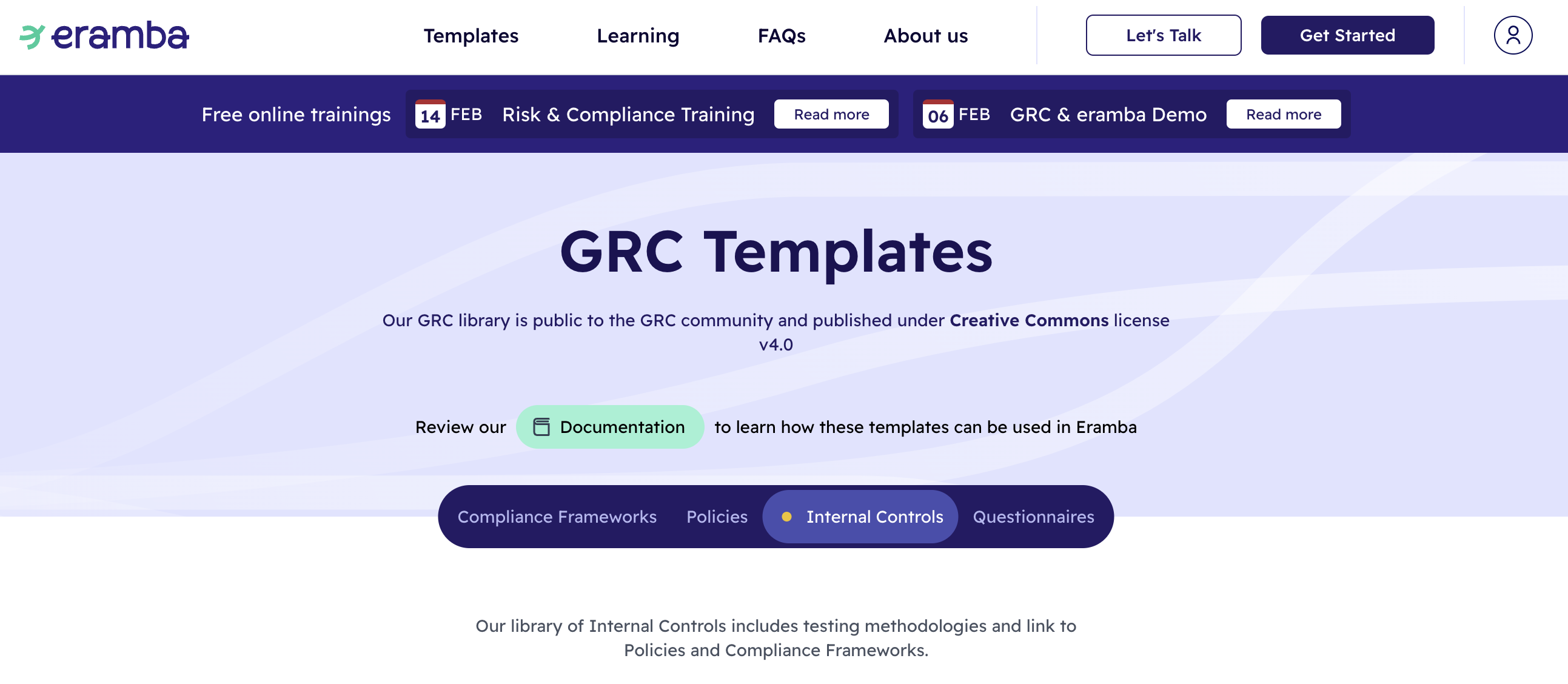Typical Internal Control Questions
Typical questions around controls and testing methodologies
Activities
The most common confusion in regard to what we in eramba call Internal Controls is that people mix them up with things like ISO, NIST, Etc. You can use any terminology you want, but we need you to understand what we mean by Internal Controls.
NIST, ISO, etc. are, what we call, compliance packages. They are a set of requirements or goals for every company on the planet. How you meet those requirements is entirely up to you. For that reason, only you know, what Internal Contros exist in your organisation.
This is why we always talk about "Problems and solutions". If this is not clear to you please review that episode before continuing.
Link to Policies
If Internal Control is an activity it must be done systematically, for example, you want all laptops to be built the same way (encryption, authentication, etc). Therefore often times (if not all the time) you will have a documented process that describes how that is done (step one, step two, etc).

The Internal Control module and the Policy module are linked one with another for this reason, ideally when a control is created you will associate "documentation", back to the "End-point encryption" example the following documents could be applicable:
- End-point device build procedure
- Encryption Standards for end-points
- Encryption Policy
- Etc
Sometimes activities are well understood and we don't need to have a piece of paper telling us how it should be done, for example, we don't need a document that explains to us how to brush our teeth!
Reflect Reality
Internal Controls are one of four "Solutions" in eramba and is very important that all your Internal Controls always reflect the reality of your organisation. A control is "real" if it meets the following criteria:

- It addresses a known problem (Risk, Compliance Requirement, Data Flow)
- There is a team that operates the activity (Internal Control)
- The control is in use, it might not work perfectly well, which is a question of maturity, but it should by all means be in use and ready to audit if needed (it might not pass audits!)
If one of the criteria mentioned above is not true, then you do not have an Internal Control. The typical scenario is something like:
- A control that is not linked to a problem is like spending money on something we most likely don't need or we need but we are not able to explain why
- Whoever performs solutions must understand what problem is solving, accountability is very important when creating Internal Controls as you need to validate their activity runs as expected
- Often we see people documenting controls "because we know someone does them" or "because we should be doing them". In eramba you only document the reality of your organisation, if something is not done control does not exist (see the Project Management course).
Projects
If a solution (Internal Control) does not exist then you might opt to create a Project (see Project course) to describe that in the future (not now) an Internal Control will exist. The association in eramba would look as shown below how the Project module links to problems (bottom) and solutions (left).

If you have a control that is "more or less" (happens more often than most people think) you can link Projects to Internal Controls or their Audits in two scenarios:
- The control is not mature, so a Project is linked
- The control is mature, but it has failed an audit. A remediation plan (project) is now linked to the audit
One to One Mapping
A problem (in GRC or pretty much anywhere else in life) can have:
- One solution (Internal Control)
- Multiple solutions (Internal Controls)
It depends on how efficiently your GRC (and to a larger extent your organisation) operates. Ideally, you aim for the least and cheapest number of solutions. In eramba, a Risk such as the one shown below can have one or multiple solutions associated:

The same can happen with a different type of problem, such as a compliance requirement or a data flow. The control "AWS SaaS Account Reviews" shown in the screenshot above as you can see is not just dealing with that risk but also with multiple compliance requirements from NIST and ISO:

Ideally, your internal controls will be "leveraged" across multiple problems, making them look a little bit like as shown above.
The typical leverage in the community is agreed to be around 5-15, that is if you have 1000 problems (in between Risks, Compliance Requirements and Data Flows) you will need some 100 or so Internal Controls. Believe it or not (this is a well-known fact) the rate at which you will create controls will be somewhat reflected in the graph below no matter the organization's size or vertical.

Initially, when implementing eramba you will identify many controls and then, you will see that you will slow down as problems start to become similar enough that by just "adjusting" existing controls you mitigate them. The curve begins to flatten at around 200-250 problems.
The reason why the organisation size or vertical does not affect the number of controls is that larger organizations standardise controls across their scope for operational efficiencies. A 200-employee company and a 20000-employee company are likely to use a centralized encryption solution, meaning one control.
Most people know what controls they have in their organisation, what you need to do is to break down that "explanation" into single items that you can create in eramba. In this course, we will teach you one way to go around this challenge.
Templates
Sometimes people expect "templates" that tell them what "Internal Controls" should "exist" for every "Problem". eramba has a library of templates available to anyone on our website.

Back to the previous point, if PCI-DSS asks everyone for Encryption, how your organisation meets that requirement is entirely up to you. There are infinite methods, technologies, and processes to achieve this, templates therefore are of little use other than inspiration.
Broad Vs. Specific
Every time you create a control you are reflecting in eramba:
- an activity
- who is doing it
- what the instructions for that activity are
- optionally how you will test it
When writing a control down you will have questions, the first one will be if you should describe the activity in "Broader" or "Specific" terms. Remember you are creating solutions for (ideally) MULTIPLE problems, not ONE. Look at the table below to see a simple example of the comparison of a broad vs specific control (remember, they are activities).
|
The broad control |
Or specific controls? |
|
Network Firewalls |
Network Configuration Standards Reviews |
|
Network Administrator Access Reviews |
|
|
Firewall Change Reviews |
There are pros and cons against creating one or the other, here is a table that summarises the issue:
|
Broad Internal Controls |
Specific Internal Controls |
|
| Leverage |
If you have 1000 problems you will not need many Internal Controls to address them all. |
If you have 1000 problems you will need many Internal Controls to address them all. |
| Audit Methodology |
Their audit will be either:
|
Their audit will be very specific, auditors will like this. This approach is much more expensive than the broad one. |
| Maturity |
Broad controls are good for GRC programs that are starting to take form. |
Specific controls will set a very high bar from the beginning and this might push your organisation too much (unnecessarily). |
| Implications of a Control Audit Fails |
If you fail an audit for a broad control you will affect many compliance requirements (since they are broad and can meet many items) and that will be reflected on your compliance report as a lot of unwanted fails. |
If you fail an audit, you will affect very few compliance requirements.
|
Testing Owners
Imagine your company performs "Change Management" in all departments, from approving a business trip to making a change in a system. Documenting Internal Controls (such as Change Management) that follow one process (activity) but are executed by different teams might result in more than one control
|
The broad control |
Or specific controls? |
|
Change Management |
Change Management - Cloud Team |
| Change Management - Applications Team | |
| Change Management - Database Team |
Imagine you create one control that includes all three teams and your audit methodology takes evidence from all three teams. What would be the result of the audit if the Applications teams messed up but the other two did well? Fail or Pass? If you set it to Fail, then the other two teams will most likely remind you they did well.
For that reason, sometimes you might need more than one control even if they relate to the same procedure.
Assets
Internal Controls are activities that reflect procedures done by teams in your organisation.
- We encrypt laptops
- We perform change management
- We provision and deprovision accounts on systems
- Etc
These activities follow a "Process" which hopefully, is systematicly performed. For example: we want to make sure all latops are encrpypted the same way in order to ensure we pass our audits and quality standards.
The number of "Assets" the "Process" (Internal Control) is completely irrelevant, a process is designed to take 1 or 1 million inputs (assets, etc). For this reason, the question of "How many controls should I create in eramba if I have 10 applications" is irrelevant.
When testing a control you will take a representative sample (out of 200 20000 or 5 million items) that will give you a representative indication (rate which produced expected outputs) of the accuracy of that procedure.
If you have 10 applications and you are provisioning accounts to these applications using 10 procedures then you most likely have 10 controls. Process homogenization is a basic management principle to increase efficacy and quality control.
Testing
Controls are activities that are intended to solve problems (e.g. Risks, Compliance Requirements, etc). Unless these activities are tested there is no certainty that problems are being addressed. For that reason, controls must be “tested” or “Audited” regularly.
For example, if a control defines that we will encrypt all laptops because there is a risk of employees losing or getting laptops stolen then we need to check periodically that all laptops have been encrypted. In eramba, for every internal control you create, you can OPTIONALLY define the following attributes for every control:
- When you will test the internal control (every 5ht of March, etc)
- How you will test it (evidence, analysis, etc)
- Sucess Criteria (how you can tell it is a pass or a fail)
If you do not trust your Internal Controls, then you need to test them more often and in more detail. If you trust your Internal Controls then you can reduce both variables.
The "cost" of testing a single control is:

For example, in the "End-Point Laptop Encryption" control example:
- I plan to test 4 times a year
- each test will take me 5 hours
- I can then budget 20 hours of work (remember, time is money).
As explained before, you will have more than one control so numbers depend in the end on three variables as shown in the table below:
|
Number of Controls |
Average number of tests per year |
The average duration of each test |
Hours Required |
|
50 |
1.5 |
3 Hours |
225 Hours / Year |
|
75 |
1.5 |
3 Hours |
315 Hours / Year |
|
100 |
3 |
3 Hours |
900 Hours / Year |
Often people ask us, how much should I test? well, it depends on how much assurance your business needs. If your boss wants to pass "PCI-DSS" audits no matter what or wants to "mitigate" all Risks no matter what, then you will need many controls and more testing to ensure all works when auditors come. You would have tested everything in advance so much you will know exactly how your company controls work.
You should be able to provide your finance team with a good estimation of the amount of money that will cost using the tables above.
Playlist
- Episode 1Introduction to the Internal Control Module12 mins left
- Episode 2Problem vs. Solution Principle - old10 mins left
- Episode 3Internal Controls Related Modules1 min left
- Episode 4Typical Internal Control Questions16 mins left
- Episode 5Identifying Internal Controls8 mins left
- Episode 6Creating an Internal Control5 mins left
- Episode 7Audits and Maintenance Tasks12 mins left